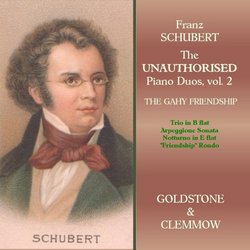Glorious Sequel
Hexameron | 05/03/2007
(5 out of 5 stars)
"For those who enjoyed Goldstone and Clemmow's first Volume Schubert: The Unauthorised Piano Duets, this sequel will come as a blessing. It's somewhat difficult to stumble upon the Divine Art label's two Schubert volumes, and I regret the fact that many Schubert lovers out there are ignorant of these two mesmerizing and invaluable recordings. Both contain a plethora of four-hand piano arrangements, most of which are of Schubert's beloved chamber music. In the first Volume, our ears were rewarded with the immaculate piano arrangement of the Trout Quintet. Here we get a similar treasure trove of Schubert's loveliest chamber music, translated into the piano's language by way of complex and exquisite arrangements.
"I count the hours I spent playing duets with Schubert among the most enjoyable of my life, and I cannot think back on that period without being overcome by the most profound emotion... My friendship with Schubert remained untroubled until his death." These are the words of Josef von Gahy, a friend of Schubert's who had the illustrious position of being Schubert's favorite piano duet partner. Gahy completed a vast number of four-hand transcriptions of Schubert's works. And these are not deficient piano reductions so often published by sixth-rate musicians and incompetent hacks. Anthony Goldstone mentions in the liner notes that Gahy "transcribed about thirty of Schubert's works" and that his "transcriptions are faithful to the originals... This leads to some extremely complicated writing in both the Notturno and the B flat major Trio, with parts of phrases flying back and forth between the two players." According to Goldstone, Gahy worked on the piano arrangement of the B flat major Trio for eight months. But one doesn't need historical facts to feel impressed; just listen to the highly effective piano arrangement of the Trio and bask in its brilliance, precision and craftsmanship.
In truth, and I know this is a dubious thing to say, I actually enjoyed the piano arrangement of the D. 898 Trio much more than its original version. Goldstone's and Clemmow's adoration and reverence for Schubert's music are such that they make no room for technical error or interpretative shortcomings. On the contrary, they imbue this work with a new breath of musical air while maintaining all the dynamism and intricacies of a well-coordinated chamber ensemble (and one can argue that they *are* a chamber duo, after all). Schubert's Piano Trio is an emotionally balanced work that employs a light first movement, a sublime second, and then two more jovial movements. With the exception of the development section in the first movement and also the Andante, Schubert has refrained from expressing sorrow, pathos or struggle. Instead, he communicates a mood of gaiety clothed in his usual melodic wrappings. Goldstone and Clemmow are of such a caliber that technique is never questioned. And their devotion to Schubert is truly remarkable; they are real amateurs in the best sense. Thus they deliver all the goods and provide a phenomenally refreshing outlook on this chamber work through the scope of the solo piano.
It can also be expected that this duo accomplishes the same feats with the famous Notturno and the Arpeggione Sonata. Gahy's wondrous arrangement of the Notturno is impossible to dislike. Although the tempo may seem faster than what one is used to, the piano duo creates stunning waves in the virtuosic passageworks. In the corresponding lyrical sections, the duo represents Schubert's ideas with clarity while sumultaneously exhibiting passion. Moving on, I think the Arpeggione Sonata receives the best pianistic treatment from Gahy and an even more stimulating aural experience through the hands of Goldstone and Clemmow. Like the Piano Trio, this music is unabashedly light-hearted, but its endearing themes are convincing enough to realize we're hearing quality music. Although actual recordings of this original work featuring the strange arpeggione instrument exist, I definitely find the Sonata more appealing as a piano arrangement. The only "authorised" piano arrangement featured here is Schubert's own "Friendship" Rondo in D major. It's assumed that this duet was intended to be played by both Gahy and Schubert as a touching testament to their friendship. The sentiment is not lost on the husband-wife team who play with affection and heart-felt joy.
Bottom line: Schubert lovers are incredibly fortunate to have such piano arrangements recorded by a stellar piano duo like Goldstone and Clemmow. Although these are not Schubert's most titanic compositions, they have endured in the hearts of many and make for gripping piano music. Since Goldstone divulged Gahy's list of arrangements as nearing thirty, I hope to see a third volume in this exciting series!"


 Track Listings (9) - Disc #1
Track Listings (9) - Disc #1